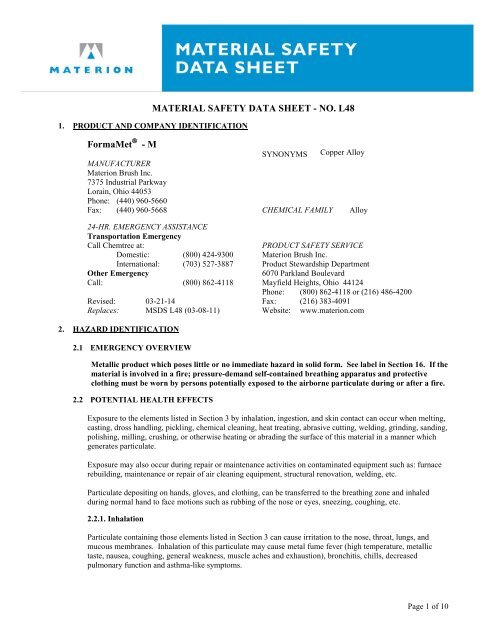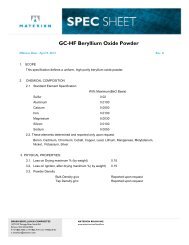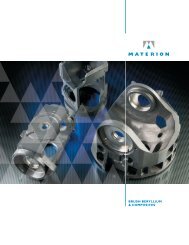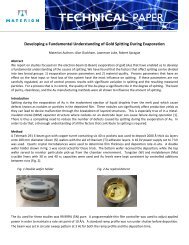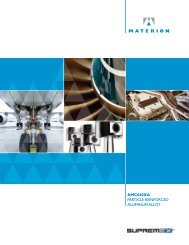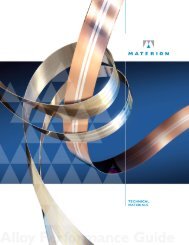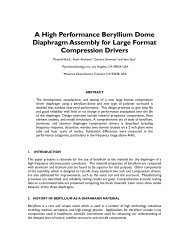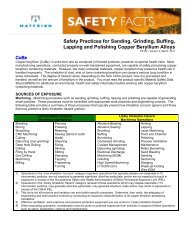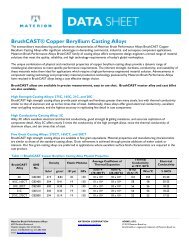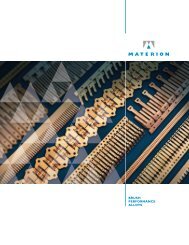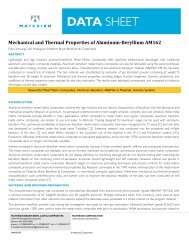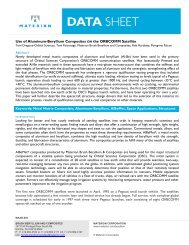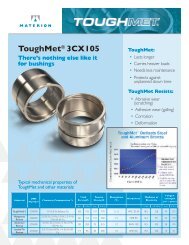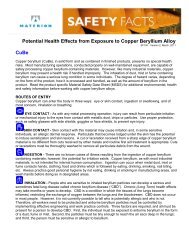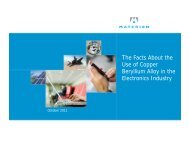FormaMet - Materion
FormaMet - Materion
FormaMet - Materion
- No tags were found...
Create successful ePaper yourself
Turn your PDF publications into a flip-book with our unique Google optimized e-Paper software.
<strong>FormaMet</strong> ® - M MSDS No. L48 March 21, 2014Cobalt: May cause asthmatic attacks due to allergic sensitization of the respiratory tract. May cause asthma andshortness of breath.Copper: Inhalation of particulate containing metallic copper can cause ulceration and perforation of the nasalseptum.Lead: Lead can be absorbed through the respiratory system. In cases of acute exposure, symptoms such asmetallic taste, chest and abdominal pain, and increased lead blood levels may follow.2.2.2. IngestionIngestion can occur from hand, clothing, food and drink contact with particulate during hand to mouthactivities such as eating, drinking, smoking, nail biting, etc.Cobalt: May cause gastrointestinal irritation with nausea, vomiting and diarrhea. May cause allergic reaction.Copper: Copper ingestion causes nausea, vomiting, abdominal pain, metallic taste, and diarrhea. Ingestion oflarge doses may cause stomach and intestine ulceration, jaundice, and kidney and liver damage.Lead: POISON! The symptoms of lead poisoning include abdominal pain and spasms, nausea, vomiting,headache. Acute poisoning can lead to muscle weakness, "lead line" on the gums, metallic taste, loss ofappetite, insomnia, dizziness, and high lead levels in blood and urine with shock, coma and death in extremecases.2.2.3. SkinSkin contact with this material may cause, in some sensitive individuals, an allergic dermal response. Skincontact may cause irritation. Symptoms include redness, itching and pain.Cobalt: Prolonged and/or repeated contact may cause dermatitis.Copper: Particulate may cause a greenish-black skin discoloration.Lead: Lead and lead compounds may be absorbed through the skin on prolonged exposure; the symptoms oflead poisoning described for ingestion exposure may occur.2.2.4. EyesExposure may result from direct contact with airborne particulate or contact to the eye with contaminatedhands or clothing. Damage can result from irritation or mechanical injury to the eyes by particulate.Copper: Particulate in the eyes may cause discoloration.Lead: Absorption can occur through eye tissues.2.2.5. Chronic (long-term health effects)Cobalt: Repeated exposure may cause allergic respiratory reaction (asthma). Chronic inhalation of particulatemay lead to restricted pulmonary function and lung fibrosis (scarring). Chronic ingestion may result in heartdamage and/or failure, vomiting, convulsions and thyroid enlargement. Repeated exposure may causesensitization dermatitis.Copper: Prolonged or repeated exposure to copper can discolor skin and hair and irritate the skin; may causemild dermatitis, runny nose, and irritation of the mucous membranes. Repeated ingestion may damage theliver and kidneys. Repeated Inhalation can cause chronic respiratory disease.Page 2 of 10
<strong>FormaMet</strong> ® - M MSDS No. L48 March 21, 2014Manganese: Substance may have carcinogenic potential. Chronic manganese toxicity through inhalation mayresult in "manganism", which is a disease of the central nervous system involving psychic and neurologicaldisorders.Lead: Lead absorption in the body is cumulative. The concentration of lead in the blood is an important aspectof assessing exposure and potential adverse health effects. Excessive concentration may cause neuromusculardysfunction accompanied by signs of weakness. Chronic lead poisoning has been associated with kidneydisorders.2.2.6. Carcinogenic ReferencesCobalt: The International Agency for Research on Cancer (IARC) lists cobalt as a Group 2B – PossiblyCarcinogenic to Humans.Lead: The International Agency for Research on Cancer (IARC) lists lead as a Group 2B – PossiblyCarcinogenic to Humans. The National Toxicology Program (NTP) lists lead as reasonably anticipated to be ahuman carcinogen.2.2.7. Medical Conditions Aggravated by ExposurePersons with impaired pulmonary function, airway diseases, or conditions such as asthma, emphysema, chronicbronchitis, etc. may incur further impairment if particulate is inhaled. If prior damage or disease to theneurologic (nervous), circulatory, hematologic (blood), or urinary (kidney) systems has occurred, properscreening or examinations should be conducted on individuals who may be exposed to further risk wherehandling and use of this material may cause exposure.Copper: Persons with pre-existing skin disorders or impaired liver, kidney, or pulmonary function or preexistingWilson's disease may be more susceptible to the effects of this material.Lead: Persons with pre-existing kidney, nerve or circulatory disorders or with skin or eye problems may bemore susceptible to the effects of this substance.2.3 POTENTIAL ENVIRONMENTAL EFFECTSSee Ecological Information (Section 12)3. COMPOSITION/INFORMATION ON INGREDIENTSCHEMICAL COMPOSITION (Percent by Weight)PRODUCT NAME OR ALLOY NUMBER(Copper Development Association UNS Number)CONSTITUENTS CAS Numbers <strong>FormaMet</strong> ®Copper 7440-50-8 BalanceAluminum 7429-90-5 12 – 17Iron 7439-89-6 3 – 7Manganese 7439-96-5 1 - 5Cobalt 7440-48-4 1 – 4Lead 7439-92-1 0.1 – 0.4Hazard Communication regulations of the U.S. Occupational Safety and Health Administration apply to thisproduct.NOTE: As used in this Material Safety Data Sheet, the term “particulate” refers to dust, mist, fume, fragments,particles and/or powder.Page 3 of 10
<strong>FormaMet</strong> ® - M MSDS No. L48 March 21, 20144. FIRST AID MEASURES4.1 FIRST AID PROCEDURESINHALATION: Breathing difficulty caused by inhalation of particulate requires immediate removal to freshair. If breathing has stopped, perform artificial respiration and obtain medical help.INGESTION: Induce vomiting immediately as directed by medical personnel. Never give anything bymouth to an unconscious person.SKIN: Thoroughly wash skin cuts or wounds to remove all particulate debris from the wound. Seek medicalattention for wounds that cannot be thoroughly cleansed. Treat skin cuts and wounds with standard first aidpractices such as cleansing, disinfecting and covering to prevent wound infection and contamination beforecontinuing work. Obtain medical help for persistent irritation. Material accidentally implanted or lodgedunder the skin must be removed.EYES: Immediately flush eyes with plenty of water for at least 15 minutes, lifting lower and upper eyelidsoccasionally. Get medical attention immediately.5. FIRE FIGHTING MEASURESFlash PointExplosive LimitsExtinguishing MediaUnusual Fire and ExplosionHazardsSpecial Fire Fighting ProceduresNon-combustible as a solid. No ignition as layer of sub 44 micronparticles of copper.Not applicable to solids. No ignition as cloud of sub 44 micron particlesof nominal copper.This material is non-combustible. Use extinguishing media appropriateto the surrounding fire.Do not use water to extinguish fires around operations involving moltenmetal due to the potential for steam explosions.Pressure-demand self-contained breathing apparatus must be worn byfirefighters or any other persons potentially exposed to the metal fumesor dust released during or after a fire.6. ACCIDENTAL RELEASE MEASURES6.1 STEPS TO BE TAKEN IF MATERIAL IS RELEASED OR SPILLEDIf this material is a particulate, establish a restricted entry zone based on the severity of the spill. Personsentering the restricted zone must wear adequate respiratory protection and protective clothing appropriate forthe severity of the spill (see Section 8). Cleanup spills with a vacuum system utilizing a high efficiencyparticulate air (HEPA) filtration system followed by wet cleaning methods. Special precautions must be takenwhen changing filters on HEPA vacuum cleaners used to clean up hazardous materials. Be careful to minimizeairborne generation of particulate and avoid contamination of air and water. Depending upon the quantity ofmaterial released into the environment, the incident may be required to be reported to the National ResponseCenter at (800) 424-8802 as well as the State Emergency Response Commission and Local EmergencyPlanning Committee.7. HANDLING AND STORAGE7.1 HANDLINGParticulate may enter the body through cuts, abrasions or other wounds on the surface of the skin. Wear gloveswhen handling parts with loose surface particulate or sharp edges.7.2 STORAGEStore in a dry area.Page 4 of 10
<strong>FormaMet</strong> ® - M MSDS No. L48 March 21, 20148. EXPOSURE CONTROLS, PERSONAL PROTECTION8.1 VENTILATION AND ENGINEERING CONTROLSWhenever possible, the use of local exhaust ventilation or other engineering controls is the preferred method ofcontrolling exposure to airborne particulate. Where utilized, exhaust inlets to the ventilation system must bepositioned as close as possible to the source of airborne generation. Avoid disruption of the airflow in the areaof a local exhaust inlet by equipment such as a man-cooling fan. Check ventilation equipment regularly toensure it is functioning properly. Provide training on the use and operation of ventilation to all users. Usequalified professionals to design and install ventilation systems.8.2 WORK PRACTICESDevelop work practices and procedures that prevent particulate from coming in contact with worker skin, hair,or personal clothing. If work practices and/or procedures are ineffective in controlling airborne exposure orvisual particulate from deposition on skin, hair, or clothing, provide appropriate cleaning/washing facilities.Procedures should be written that clearly communicate the facility’s requirements for protective clothing andpersonal hygiene. These clothing and personal hygiene requirements help keep particulate from being spreadto non-production areas or from being taken home by the worker. Never use compressed air to clean workclothing or other surfaces.Fabrication processes may leave a residue of particulate on the surface of parts, products or equipment thatcould result in employee exposure during subsequent material handling activities. As necessary, clean looseparticulate from parts between processing steps. As a standard hygiene practice, wash hands before eating orsmoking.To prevent exposure, remove surface scale or oxidation formed on cast or heat treated products in anadequately ventilated process prior to working the surface.8.3 WET METHODSMachining operations are usually performed under a liquid lubricant/coolant flood which assists in reducingairborne particulate. However, the cycling through of machine coolant containing finely divided particulate insuspension can result in the concentration building to a point where the particulate may become airborneduring use. Certain processes such as sanding and grinding may require complete hooded containment andlocal exhaust ventilation. Prevent coolant from splashing onto floor areas, external structures or operators’clothing. Utilize a coolant filtering system to remove particulate from the coolant.8.4 RESPIRATORY PROTECTIONWhen airborne exposures exceed or have the potential to exceed the occupational limits shown in Section 8.13,approved respirators must be used as specified by an Industrial Hygienist or other qualified professional.Respirator users must be medically evaluated to determine if they are physically capable of wearing arespirator. Quantitative and/or qualitative fit testing and respirator training must be satisfactorily completed byall personnel prior to respirator use. Users of tight fitting respirators must be clean shaven on those areas of theface where the respirator seal contacts the face. Exposure to unknown concentrations of particulate requiresthe wearing of a pressure-demand airline respirator or pressure-demand self-contained breathing apparatus(SCBA). Use pressure-demand airline respirators when performing jobs with high potential exposures such aschanging filters in a baghouse air cleaning device.8.5 OTHER PROTECTIVE EQUIPMENTProtective overgarments or work clothing must be worn by persons who may become contaminated withparticulate during activities such as machining, furnace rebuilding, air cleaning equipment filter changes,maintenance, furnace tending, etc. Contaminated work clothing and overgarments must be managed in aPage 5 of 10
<strong>FormaMet</strong> ® - M MSDS No. L48 March 21, 2014controlled manner to prevent secondary exposure to workers of third parties, to prevent the spread ofparticulate to other areas, and to prevent particulate from being taken home by workers.8.6 PROTECTIVE GLOVESWear gloves to prevent contact with particulate or solutions. Wear gloves to prevent metal cuts and skinabrasions during handling.8.7 EYE PROTECTIONWear safety glasses, goggles, face shield or welder’s helmet when risk of eye injury is present, particularlyduring melting, casting, machining, grinding, welding, powder handling, etc.8.8 HOUSEKEEPINGUse vacuum and wet cleaning methods for particulate removal from surfaces. Be certain to de-energizeelectrical systems, as necessary, before beginning wet cleaning. Use vacuum cleaners with high efficiencyparticulate air (HEPA). Do not use compressed air, brooms, or conventional vacuum cleaners to removeparticulate from surfaces as this activity can result in elevated exposures to airborne particulate. Follow themanufacturer’s instructions when performing maintenance on HEPA filtered vacuums used to clean hazardousmaterials.8.9 MAINTENANCEDuring repair or maintenance activities the potential exists for exposures to particulate in excess of theoccupational standards. Under these circumstances, protecting workers can require the use of specific workpractices or procedures involving the combined use of ventilation, wet and vacuum cleaning methods,respiratory protection, decontamination, special protective clothing, and when necessary, restricted workzones.8.10 WELDINGLocal exhaust or general ventilating systems must be provided and arranged to keep the amount of toxic fumes,gases, or dusts below the maximum allowable concentration for the constituents listed in Section 3.8.11 EXPOSURE CHARACTERIZATIONDetermine exposure to airborne particulate by air sampling in the employee breathing zone, work area, anddepartment. Utilize an Industrial Hygienist or other qualified professional to specify the frequency and type ofair sampling. Develop and utilize a sampling strategy which identifies the extent of exposure variation andprovides statistical confidence in the results. Conduct an exposure risk assessment of processes to determine ifconditions or situations exist which dictate the need for additional controls or improved work practices. Makeair sample results available to employees.8.12 MEDICAL SURVEILLANCELead: Refer to the OSHA substance-specific standard for more information on medical surveillance and recordkeeping requirements. (29 CFR 1910.1025).Page 6 of 10
<strong>FormaMet</strong> ® - M MSDS No. L48 March 21, 20148.13 OCCUPATIONAL EXPOSURE LIMITSCONSTITUENTS OSHA* ACGIH*NIOSH RTECSNUMBERPEL CEILING PEAK TLV TLV-STELAluminum (as Al)Total Dust 15 N/A N/A N/A N/A BD0330000Aluminum (as Al)Respirable 5 N/A N/A 1 N/A BD0330000Cobalt 0.1 N/A N/A 0.02 N/A GF8750000Copper Dust & Mist 1 N/A N/A 1 N/A GL5325000Copper Fume 0.1 N/A N/A 0.2 N/A GL5325000Iron Oxide Fume 10 N/A N/A N/A N/A NO456550Iron OxideRespirable N/A N/A N/A 5 N/A NO7400000Manganese (as Mn) N/A 5 N/A 0.2 N/A OO9275000Lead 0.05 N/A N/A 0.05 N/A OF7525000*ALL CONCENTRATIONS ARE IN MILLIGRAMS PER CUBIC METER OF AIR(at the concentrations noted above, these constituents may not be visible to the human eye)A leading scientific body recommending occupational standards is the American Conference of GovernmentalIndustrial Hygienists (ACGIH). The ACGIH recommends standards for all listed substances. The ACGIHdefines a threshold limit value (standard) as follows: “Threshold Limit Values refer to airborne concentrationsof substances and represent conditions under which it is believed that nearly all workers may be repeatedlyexposed day after day without adverse health effects. Because of wide variation in individual susceptibility,however, a small percentage of workers may experience discomfort from some substances at concentrations ator below the threshold limit; a smaller percentage may be affected more seriously by aggravation of a preexistingcondition or by development of an occupational illness.” “Individuals may also be hypersusceptible orotherwise unusually responsive to some industrial chemicals because of genetic factors, age, personal habits(smoking, alcohol, or other drugs), medication, or previous exposures. Such workers may not be adequatelyprotected from adverse health effects from certain chemicals at concentrations at or below the thresholdlimits.”ACGIH = American Conference of Governmental Industrial HygienistsOSHA = Occupational Safety and Health AdministrationPEL = Eight-Hour Average Permissible Exposure Limit (OSHA)CEILING = Not To Be Exceeded Except for Peak Limit (OSHA)PEAK = 30-Minute Maximum Duration Concentration Above Ceiling Limit (OSHA)TLV = Eight-Hour Average Threshold Limit Value (ACGIH)TLV-STEL = 15-Minute Short Term Exposure Limit (ACGIH)CAS = Chemical Abstract ServiceNIOSH = National Institute for Occupational Safety and HealthRTECS = Registry of Toxic Effects of Chemical SubstancesN/A = Not ApplicableFollowing good industrial hygiene practice, which includes reducing airborne exposures to the lowest feasiblelevel for all constituents in this product, is recommended.9. PHYSICAL AND CHEMICAL PROPERTIESPHYSICAL PROPERTIESBoiling Point: Not Applicable Radioactivity: Not ApplicableEvaporation Rate: Not Applicable Solubility: NonePage 7 of 10
<strong>FormaMet</strong> ® - M MSDS No. L48 March 21, 2014Freezing Point: Not Applicable Sublimes At Not ApplicableOdor: None Vapor Density (Air = 1): Not ApplicablepH: Not Applicable Vapor Pressure (mmHg): Not ApplicablePhysical State: Solid % Volatiles By Volume: NoneColor: Yellow Melting Point (°F): 2000Density (lb/in3): 0.25110. STABILITY AND REACTIVITYGeneral ReactivityIncompatibility (materials toavoid)Hazardous DecompositionProductsHazardous PolymerizationThe material is stableAvoid contact with mineral acids and oxidizing agents which may generatehydrogen gas. Hydrogen gas can be an explosion hazard.None under normal conditions of use.Will not occur11. TOXICOLOGICAL INFORMATIONFor questions concerning toxicological information, write to: Medical Director, <strong>Materion</strong> Brush Inc., 14710 WestPortage River South Road, Elmore, Ohio 43416-9502.12. ECOLOGICAL INFORMATIONThis material can be recycled; contact your Sales Representative.13. DISPOSAL CONSIDERATIONS13.1 BYPRODUCT RECYCLINGWhen recycled (used in a process to recover metals), this material is not classified as hazardous waste underfederal law. Seal particulate or particulate containing materials inside two plastic bags, place in a DOTapproved container, and label appropriately.13.2 SOLID WASTE MANAGEMENTWhen spent products are declared solid wastes (no longer recyclable), they must be labeled, managed anddisposed of, in accordance with federal, state and local requirements. This material contains the followingmetal regulated under RCRA: lead. See Section 2 for chemical composition.14. TRANSPORT INFORMATIONThere are no U.S. Department of Transportation hazardous material regulations which apply to the packagingand labeling of this product as shipped.Hazard Communication regulations of the U.S. Occupational Safety and Health Administration require thisproduct be labeled.15. REGULATORY INFORMATION15.1. UNITED STATES FEDERAL REGULATIONS15.1.1 Occupational Safety and Health Administration (OSHA)Air contaminants, 29 CFR 1910.1000Hazard Communication Standard, 29 CFR 1910.1200OSHA Lead Standard 29 CFR 1910.1025Page 8 of 10
<strong>FormaMet</strong> ® - M MSDS No. L48 March 21, 201415.1.2 Environmental Protection Agency (EPA)AMBIENT AIR EMISSIONS: Most process air emission sources will require an air permit from a localand/or state air pollution control agency. The use of air cleaning equipment may be necessary to achieve thepermissible emission. Tempered makeup air should be provided to prevent excessive negative pressure in abuilding. Direct recycling of cleaned process exhaust air is not recommended. Plant exhausts should belocated so as not to re-enter the plant through makeup air or other inlets. Regular maintenance and inspectionof air cleaning equipment and monitoring of operating parameters is recommended to ensure adequateefficiency is maintained.WASTEWATER: Wastewater regulations can vary considerably. Contact your local and state governmentsto determine their requirements.TOXIC SUBSTANCES CONTROL ACT: Component(s) of this material is/are listed on the TSCAChemical Substance Inventory of Existing Chemical SubstancesSARA TITLE III REPORTING REQUIREMENTS: On February 16, 1988, the U.S. EnvironmentalProtection Agency (EPA) issued a final rule that implements the requirements of the Superfund Amendmentsand Reauthorization Act (SARA) Title III, Section 313 (53) Federal Register 4525. Title III is the portion ofSARA concerning emergency planning and community right-to-know issues. Section 313 covers annualemission reporting on specific chemicals which are manufactured, processed or used at certain U.S. Industrialfacilities.These products are reportable under the Section 313 category of Compounds and/or Mixtures. These mixturescontain one or more of the following reportable constituents: Aluminum, Cobalt, Copper and Manganese. Thespecific chemical makeup, concentration by weight and the Chemical Abstracts Services number for each ofour products is provided in Section 3.You may obtain additional information by calling the EPA SARA Title III Hotline at 1-800-535-0202(or 703-412-9810).15.2 STATE REGULATIONSAluminum• Is listed on the following state right-to-know lists: California, New Jersey, Florida, Pennsylvania,Minnesota and Massachusetts.• California No Significant Risk Level: Not ListedCobalt• Is listed on the following state right-to-know lists: California, New Jersey, Florida, Pennsylvania,Minnesota and Massachusetts.• The following statement is made in order to comply with the California Safe Drinking Water ActWARNING: This product contains COBALT, a chemical known to the state of California to causecancer.• California No Significant Risk Level: Not listed.Copper• Is listed on the following state right-to-know lists: California, New Jersey, Florida, Pennsylvania,Minnesota and Massachusetts.• California No Significant Risk Level: Not listed.Manganese• Is listed on the following state right-to-know lists: California, New Jersey, Florida, Pennsylvania,Minnesota and Massachusetts.• California No Significant Risk Level: Not Listed• The following statement is made in order to comply with the California Safe Drinking Water Act -WARNING: This product contains LEAD, a chemical known to the state of California to causecancer, birth defects or other reproductive harm.• California No Significant Risk Level: NOEL = 0.5 μg/dayPage 9 of 10
<strong>FormaMet</strong> ® - M MSDS No. L48 March 21, 201415.3 CANADA16. OTHER INFORMATIONConstituent DSL/NDSL WHMIS Classification Ingredient Disclosure ListAluminum Yes/No D2B YesCobalt Yes/No D2A,D2B YesCopper Yes/No D2B YesManganese Yes/No D2A YesLead Yes/No D2A YesFollowing is the label which accompanies this product during shipment.L48<strong>FormaMet</strong> ® - MWARNINGINHALING DUST OR FUMES MAY CAUSE ACUTE LEAD POISINING. OVEREXPOSURE TO METALDUST OR FUMES CAN CAUSE METAL FUME FEVERREAD THE MATERIAL SAFETY DATA SHEET (MSDS) ON FILE WITH YOUR EMPLOYER BEFOREWORKING WITH THIS MATERIAL.This product contains cobalt and lead. Excessive inhalation or ingestion of lead can cause acute lead poisoning.• In solid form and as contained in finished products presents no special health risks.• If processing or recycling produces particulate, use exhaust ventilation or other controls designed to preventexposure to workers. Examples of such activities include melting, welding, grinding, abrasive sawing, sandingand polishing. Any activity which abrades the surface of this material can generate airborne particulate.• The Occupational Safety and Health Administration (OSHA) has set mandatory limits on occupationalexposures.• Cobalt and lead are classified as a potential cancer hazard.• Sold for manufacturing purposes only. This product can be recycled; contact your sales representative.The Occupational Safety and Health Administration requires employers to provide training in the proper use of thisproduct.For further information, please telephone or write to: Product Stewardship Department, <strong>Materion</strong> Brush Inc.,6070 Parkland Boulevard, Mayfield Heights, Ohio 44124, telephone: (800) 862-4118, www.materion.com.For transportation emergency call Chemtrec at (800) 424-9300.L48*Label may vary in size*Label color (light pink edge with black lettering)This MSDS has been revised following the guidelines outlined in the American National Standard forHazardous Industrial Chemicals -“Material Safety Data Sheets - Preparation.” Z400.1-2004MSDS Status:Date changeIMPORTANT: If you have any questions or require additional information regarding the materialsdescribed in this Material Safety Data Sheet, please telephone or write to the Product StewardshipDepartment at the location given on page 1. Additional product safety information, such as Safety Facts,is available from your sales representative or at http://www.materion.com/.<strong>FormaMet</strong> ® is a registered trademark of <strong>Materion</strong> Brush Inc.Page 10 of 10


